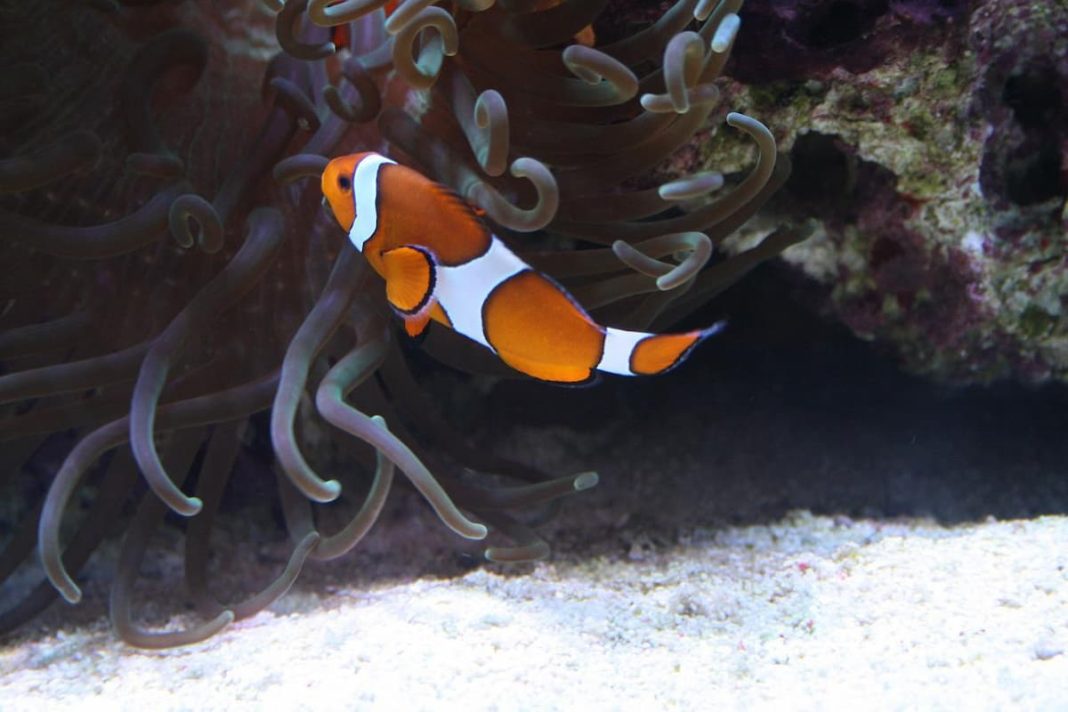Contents
- The Main Reasons A Clownfish Is Sleeping On Sand
- Is Your Clownfish Resting?
- Do Clownfish Ever Sleep?
- Other Reasons A Clownfish Is Sleeping On Sand
If you’ve got a clownfish in your aquarium, you may have witnessed some strange habits and manners. One of them is that the clownfish may sometimes sleep on the sand, which can be quite confusing and concerning for new owners. So why are your clownfish sleeping on the sand?
A clownfish could be sleeping on the sand bed of the tank because of the water parameters or the temperature of the aquarium being incorrect. Also, this kind of behavior can be considered normal for clownfish and indicates no concrete motive, so doesn’t necessarily mean that there’s a problem with your clownfish.
Some new owners can become confused seeing their playful and energetic clownfish suddenly lying motionless on the sand of the tank. Although there may be a reason to feel nervous as the fish may have a disease, generally however this kind of behavior characterizes a lot of fish species.
In this article, we will talk about the main reasons that cause this type of behavior and help you get more familiar with your clownfish. Let’s start!
The Main Reasons A Clownfish Is Sleeping On Sand
As previously mentioned, laying on the aquarium’s sand could be caused for different reasons. Although the majority of these reasons are harmless, it’s recommended for owners of clownfish to take this case seriously. The worst-case scenario could be poisoning or disease causing the fish to stay immobile and may end up dead if you don’t pay attention timely.
The major disease that affects a lot of fish species is swim bladder disease, which is not treatable in most cases. As for poisoning, there could be two major causes – ammonia poisoning and nitrate poisoning. There’re also other stress-related issues that we’ll cover below.
Usually, it’s normal for clownfish as well as other species to sometimes stay at the bottom of the tank around the sand. It could be the place they find most comfortable to rest and sleep at night. If this is the case, there’s nothing to be worried about as long as they aren’t showing any signs of illness.
Another reason could be related to the size of your aquarium or the water temperature. If your aquarium is too small or the temperature of the water is too hot, the clownfish will most likely find the bottom of the tank the most pleasant place to stay.
Is Your Clownfish Resting?
We have already mentioned that most of the time, this type of behavior is quite normal for many species of fish. The clownfish is no exception. Like other living creatures, fish require places to rest and sometimes they find the bottom of the aquarium the most comfortable place to lay.
Therefore, if your clownfish are not showing any sign of disease and the aquarium conditions are good, you shouldn’t be worried. In most cases, a clownfish is laying on the bottom of the tank is to simply relax.
Do Clownfish Ever Sleep?
As for every living creature, sleeping is very important for fish as well. They need to sleep well at night to get energy during the day and therefore it’s one of the most common reasons for them to lie on top of the sand.
It’s normal when the tank lights are turned off that a clownfish will dive to the bottom to rest and sleep at night. Leaving the lights on could cause some difficulties for the fish during the daytime. If they can’t get enough sleep at night, you may start to see them snoozing at the bottom of the aquarium during the day.
This is another reason showing that your clownfish is completely fine, and it is just showing this behavior for understandable purposes.
Other Reasons A Clownfish Is Sleeping On Sand
There can be other, more concerning reasons a clownfish may lie at the bottom of an aquarium:
Trying To Hide
You may notice a clownfish laying at the bottom of the tank, even though they’re typically mid-level swimmers.
You should monitor the fish, and see what happens whenever it tries to swim away from the bottom. If your clownfish is getting harassed by another fish, then there’s a clear tank mate incompatibility issue.
This can also happen if:
- Your tank is not large enough
- The tank is overstocked
- There are too many fish sharing the same swimming level in a tank
Solutions
- Identify the potential bully/harasser, and remove it if the harassment continues past the “asserting dominance” phase. Repeat offenders can seriously injure other tank mates if no action is taken.
- Check to see if your tank is overstocked. If your tank is overcrowded, then you defiantly need to consider getting a bigger tank.
- If you have an additional tank, consider using it for distressed fish.
Territorial Behavior
In the opposite scenario to the one listed above; a territorial clownfish may lie at the bottom of the tank to claim it as its territory. This rarely happens in a well-established tank.
If you see fights for dominance and general aggressive behavior happening mostly at the bottom level of the tank, then a struggle for territory could be the root cause of this behavior.
Solutions
- Make sure your tank setup is large enough to allow territorial fish to claim their own territory within it.
- In a tank that’s too small, there’s a high probability of aggression happening at some point. It may be hard for aggressive fish to avoid staying out of each other’s space.
Conclusion
In this article, we have touched on some reasons a clownfish could be lying or sleeping on the sand. Clownfish may display some odd behaviors from time to time and you may find them lying on the bottom of the tank frequently.








